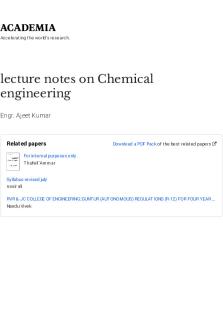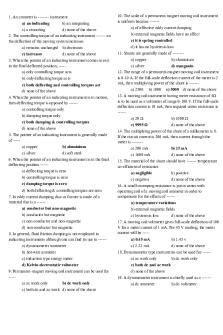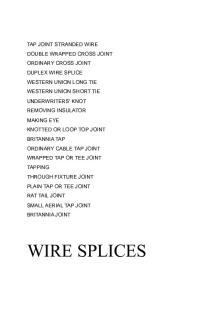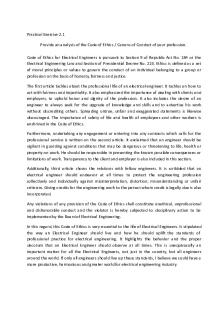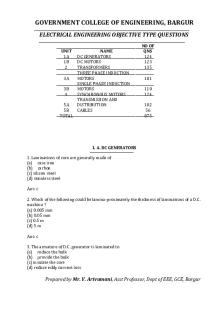LECTURE NOTES ON UTILIZATION OF ELECTRICAL ENGINEERING PDF

| Title | LECTURE NOTES ON UTILIZATION OF ELECTRICAL ENGINEERING |
|---|---|
| Author | Amit Kumar |
| Pages | 421 |
| File Size | 43.7 MB |
| File Type | |
| Total Downloads | 51 |
| Total Views | 138 |
Summary
Smartzworld.com Smartworld.asia LECTURE NOTES ON UTILIZATION OF ELECTRICAL ENGINEERING IV B. Tech I semester (JNTUH-R09) ELECTRICAL AND ELECTRONICS ENGINEERING jntuworldupdates.org Specworld.in Smartzworld.com Smartworld.asia UNIT 1 Electric Drives 1.1 INTRODUCTION Motor control is required in large...
Description
Smartzworld.com
Smartworld.asia
LECTURE NOTES ON
UTILIZATION OF ELECTRICAL ENGINEERING IV B. Tech I semester (JNTUH-R09)
ELECTRICAL AND ELECTRONICS ENGINEERING
jntuworldupdates.org
Specworld.in
Smartzworld.com
Smartworld.asia
UNIT 1 Electric Drives 1.1 INTRODUCTION
Motor control is required in large number of industrial and domestic applications such as transportation systems, rolling mills, paper machines, textile mills, machine tools, fans, pumps, robots, and washing machines. Systems employed for motion control are calleddrives and may employ any of the prime movers. Drives employing electric motors are known as electric drives. Nowadays, in electric power stations generating large amounts of electric energy for agriculture, industry, domestic needs, and electrified traction facilities and in driving all kinds of working machines, electric motor is essential, which is the predominant type of drive so the term electric drive being applied to it. Electric drive becomes more popular because of its simplicity, reliability, cleanliness, easiness, and smooth control. Both AC and DC motors are used as electric drives; however, the AC system is preferred because: o
It is cheaper.
o
It can be easily transmitted with low-line losses.
o
It can be easy to maintain the voltage at consumer premises within prescribed limits.
o
It is possible to increase or decrease the voltage without appreciable loss of power.
In spite of the advantages of AC motor, sometimes DC motor is used because: o
In some processes, such as electrochemical and battery charging, DC is the only type of power that is suitable.
o
The speed control of DC motors is easy rather than AC; thus, for variable speed applications such as lift and Ward Leonard system, the DC motors are preferred.
o
DC series motor is suited for traction work because of high starting torque.
1.2 BLOCK DIAGRAM OF ELECTRIC DRIVE
Source 1-φ and 3-φ, 50-Hz AC supplies are readily available in most locations. Very low power drives are generally fed from 1-φ source; however, the high power drives are powered from 3-φsource; some of the drives are powered from a battery
jntuworldupdates.org
Specworld.in
Smartzworld.com
Smartworld.asia
Fig. Block diagram of electric drive
Ex: Fork lifts trucks and milk vans.
Power modulator Power modulator performs the following functions: o
It modulates flow of power from the source to the motor is impart speed−torque characteristics required by the load.
o
It regulates source and motor currents within permissible values, such as starting, braking, and speed reversal conditions.
o
Selects the mode of operation of motor, i.e., motoring or braking.
o
Converts source energy in the form suitable to the motor.
Electrical motors Motors commonly used in electric drives are DC motors, induction motors, synchronous motors, blushless DC motors, stepper motors, and switched reluctance motors, etc. In olden days, induction and synchronous motors were employed mainly for constant speed drives but not for variable speed drives, because of poor efficiency and are too expensive. But in nowadays, AC motors employed in variable speed drives due to the development of semiconductors employing SCRs, power transistors, IGBTs, and GTOs.
jntuworldupdates.org
Specworld.in
Smartzworld.com
Smartworld.asia
Load It is usually a machinery, such as fans, pumps, robots, and washing machines, designed to perform a given task, usually load requirements, can be specified in terms of speed and torque demands.
Control unit Control unit controls the function of power modulator. The nature of control unit for a particular drive depends on the type of power modulator used. When semiconductor converters are used, the control unit will consists of firing circuits. Microprocessors also used when sophisticated control is required.
Sensing unit Sensing unit consists of speed sensor or current sensor. The sensing of speed is required for the implementation of closed loop speed control schemes. Speed is usually sensed using tachometers coupled to the motor shaft. Current sensing is required for the implementation of current limit control.
Advantages of electric drives There are a number of inherent advantages that the electric drive possesses over the other forms of conventional drives are: o
They have comparatively long life than the mechanical drive.
o
It is cleaner, as there are no flue gases, etc.
o
It is more economical.
o
They have flexible control characteristics.
o
There is no need to store fuel or transportation.
o
It requires less maintenance.
o
Do not pollute environment.
o
It is the reliable source of drive.
o
The electrical energy can be easily transmitted by using transmission lines over long distances.
o
Available in wide range of torque, speed, and power.
o
High efficiency.
o
Electric braking system is much superior and economical.
o
Smooth speed control is easy.
o
They can be started instantly and can immediately be fully loaded.
o
They can operate in all the quadrants of speed torque plane.
o
Being compactness, they require less space.
o
They can be controlled remotely.
jntuworldupdates.org
Specworld.in
Smartzworld.com
Smartworld.asia
Disadvantages of electric drives The two inherit disadvantages of the electric drive system are: o
The non-availability of drive on the failure of electrical power supply.
o
It cannot be employed in distant places where electric power supply is not available.
TYPES OF ELECTRIC DRIVES
Depending on the type of equipment used to ran the electric motors in industrial purpose, they may be classified into three types. They are: 1.
Group drives.
2.
Individual drives.
3.
Multi-motor drives.
Group drives Electric drive that is used to drive one or more than two machines from line shaft through belts and pulleys is known as group drive. It is also sometimes called the line shaft drive.This drive is economical in the consideration of the cost of motor and control gear. A single motor of large capacity cost is less than the total cost of a number of small motors of the same total capacity. In switch over from non-electric drive to electric drive, the simplest way is to replace the engine by means of motor and retaining the rest of power transmission system.
Advantages o
The cost of installation is less. For example, if the power requirement of each machine is 10 HP and there are five machines in the group, then the cost of five motors will be more than one 50-HP motor.
o
If it is operated at rated load, the efficiency and power factor of large group drive motor will be high.
o
The maintenance cost of single large capacity motor is less than number of small capacity motors.
o
It is used for the processes where the stoppage of one operation necessitates the stoppages of sequence of operations as incase of textile mills.
o
It has overload capacity.
Disadvantage Even though group drive has above advantages, it suffers from the following disadvantages. o
If there is any fault in the main motor, all the machines connected to the motor will fail to operate; thereby, paralyzing a part of industry until the fault is removed.
o
It is not possible to install any machine at a distant place.
o
The possibility of the installation of additional machines in an existing industry is limited.
jntuworldupdates.org
Specworld.in
Smartzworld.com
Smartworld.asia
o
The level of noise produced at the work site is quite large.
o
The speed control of different machines using belts and pulleys is difficult.
o
The flexibility of layout is lost due to line shaft, belts, and pulleys.
Individual drive In individual drive, a single electric motor is used to drive one individual machine. Such a drive is very common in most of the industries.
Advantages o
It is more clean and safety.
o
Machines can be located at convenient places.
o
If there is a fault in one motor, the output and operation of the other motors will not be effected.
o
The continuity in the production of the industry is ensured to a higher degree.
o
Individual drive is preferred for new factories, as it causes some saving in the cost.
Disadvantage o
Initial cost will be high.
o
Power loss is high.
Multi-motor drive In multi-motor drives, several separate motors are provided for operating different parts of the same machine. Ex: In traveling cranes, three motors are used for hoisting, long travel, and cross-travel motions. Multi-motor drive is used in complicated metal cutting machine tools, rolling mills, paper making machines, etc. CHOICE OF MOTORS
The selection of the driving motor for a given service depends upon the conditions under which it has to operate. Due to the universal adoption of electric drive, it has become necessary for the manufacturer to manufacture motors of various designs according to the suitability and the use in various designs according to the suitability and the use in various classes of industry. This has resulted into numerous types of motors. For this reason, the selection of motor itself has become an important and tedious process. The conditions under which an electric motor has to operate and the type of load it has to handle, determine its selection. While selecting a motor, the following factors must be taken into consideration:
jntuworldupdates.org
Specworld.in
Smartzworld.com
1.
1. 2.
Smartworld.asia
Cost:
initial cost and running cost. Electric characteristics:
0. 1. 2. 3.
starting characteristics, running characteristics, speed control characteristics, and braking characteristics. Mechanical characteristics:
0. 1. 2. 3.
type enclosure and bearings, arrangement for the transmission of power, noise, and cooling. Size and vetting of motors:
0. 1.
requirements for continuous, Intermittent, or variable load cycle and overload capacity. Type of drive:
0. 1.
the drive is for one or more machines and the type of transmission through gears, belts, etc. Nature of supply.
From the above, it is seen that a large number of factors are to be considered in making the choice of an electric motor for a given drive. The motor selected must fulfill all the necessary load requirements and at the same time, it should not be very costly if it has to be a commercial success. The factors motioned above will be individually discussed in the following sections to bring home to the reader the importance of each. While making the final choice of the motor, a satisfactory compromise may have to be made in some cases on account of the conflicting requirements. CHARACTERISTICS OF DC MOTOR
The performance and, therefore, suitability of a DC motor are determined from its characteristics. The important characteristics of DC motor are:
jntuworldupdates.org
Specworld.in
Smartzworld.com
1.
Smartworld.asia
Torque vs. armature current characteristics (T vs. Ia):
This characteristic curve gives relation between torque developed in the armature (T) and armature current (Ia). This is also known as electrical characteristic. 2.
Speed vs. armature current characteristics (N vs. Ia):
This characteristic curve gives relation between speed (N) and armature current (Ia). This is also known as speed characteristics. 3.
Output (HP) vs. armature current characteristics (HP vs. Ia):
The horse power of the motor is dependent on the shaft torque, so its characteristics follows shaft torque characteristic. 4.
Speed vs. characteristics (N vs. T):
This characteristic gives relation between speed (N) and torque (T) developed in the armature. This curve may be derived from the two characteristics mentioned in characteristics (i) and (ii) above. Characteristics (i), (ii), and (iii) are called starting characteristics, and (iv) is known asrunning characteristics. While discussing motor characteristics, the following relations should always be kept in mind.
where Ta is the torque developed in the armature in N-m, Ia is the armature current in ampere, Eb is the back emf in volts, and φ is the flux in weber.
Characteristics of shunt motor The field winding connected across the armature terminals called as shunt motor as shown in Fig.. Rated voltage is applied across the field and armature terminals.
jntuworldupdates.org
Specworld.in
Smartzworld.com
Smartworld.asia
Fig. DC shunt motor
Starting characteristics The study of starting characteristics of a motor is essential to know the starting torque necessary to accelerate the motor from standstill position is also to require to overcome the static friction and the standstill load or, to provide load torque. Torque vs. armature current (T Vs Ia)
In the expression for the torque of a DC motor, torque is directly proportional to the product of flux per pole (φ) and armature current (Ia):
Since, in case of a DC shunt motor, the flux per pole (φ) is considered to be constant.
∴ T ∝ Ia.
So, the torque is proportional to armature current and is practically a straight line passing through the origin as shown if Fig. 1.3.
jntuworldupdates.org
Specworld.in
Smartzworld.com
Smartworld.asia
Fig. 1.3 Torque vs. armature current characteristics
To generate high starting torque, this type of motor requires a large value of armature current at starting. This may damage the motor, hence DC shunt motors can develop moderate starting torque and hence suitable for such applications where starting torque requirement is moderate. Speed vs. armature current (N Vs Ia)
In shunt motor, the applied voltage ‘ V' is kept constant, the field current will remain constant, and hence the flux will have maximum value on no load due to the armature reaction; if load on the motor increases, the flux will be slightly decrease. By neglecting the armature reaction, the flux is almost constant. From the speed equation of DC shunt motor:
where Eb = V − IaRa
Since, for DC shunt motor, the flux per pole is considered to be constant.
So, as the load on the motor increases, the armature current increases and hence IaRa drop also increases. For constant supply, the voltage (V-IaRa) decreases and hence the speed reduces.
jntuworldupdates.org
Specworld.in
Smartzworld.com
Smartworld.asia
Hence, as armature current increases, the speed of the DC motor decreases. The variation of speed with armature current is shown in Fig. 1.4.
Fig. 1.4 Speed vs. armature current characteristics Output vs. armature current
The output of the motor is dependent on the shaft torque. If the armature current increases, the output of the motor gradually increases. The variation of output with the armature current is shown in Fig. 1.5.
Fig. 1.5 Armature current and HP characteristics
jntuworldupdates.org
Specworld.in
Smartzworld.com
Smartworld.asia
Running characteristics Speed-torque characteristics (N vs. T)
These characteristics can be derived from its staring characteristics of (i) and (ii). During the steady-state operation of the motor, the voltage equation of the armature circuit is given by:
where V is the applied voltage, Eb is the back emf of motor, Ia is the armature current, and Rais the armature resistance. The back emf of motor can be expressed as:
Eb ∝φ N
∴Eb = K φ N,
where K is the constant, Substituting Eb from Equation (8.3) in above equation:
The torque of the motor is directly proportional to product of flux and armature current.
jntuworldupdates.org
Specworld.in
Smartzworld.com
Smartworld.asia
Substitute Equation (8.6) in Equation (8.4), we get:
Since, the shunt motor flux is constant, the speed of the motor is:
where K1 = Kφ.
When V and Ra are kept constant, the speed torque characteristic is a straight line. If the load on the motor increases, thus the torque increases and hence the speed of the motor decreases. The characteristic curve can be drawn from the
jntuworldupdates.org
Specworld.in
Smartzworld.com
Smartworld.asia
Fig. 1.6 Speed and torque characteristics
Characteristics of DC series motor In case of series motor, the field windings are connected in series with armature terminals as shown in Fig. 1.7. Since, the field winding is connected in series with the armature winding, the load current (IL) is equals to the armature current (Ia) or the series field current (Ise).
Fig. 1.7 DC series motor
∴ IL = Ia = Ise.
jntuworldupdates.org
Specworld.in
Smartzworld.com
Smartworld.asia
Starting characteristics Torque vs. armature current (T Vs Ia)
In case of DC motors, torque is directly proportional to the product of flux per pole (φ) and armature current (Ia).
∴ T ∝ φ Ia.
Up to the saturation point, the flux is proportional to the field current and hence the armature current:
i.e., φ ∝ Ise ∝ Ia.
Therefore, the torque is proportional to the square of the armature current.
Hence, the curve drawn in Fig. 8.8; the torque and the armature currents are parabolas, up to saturation point. After saturation, the flux (φ) is almost independent of the excitation current and so the torque is proportional to the armature current, i.e., T ∝ Ia. Hence the characteristics become a straight line. The variation of torque with the armature current is shown in Fig. 8.8.
jntuworldupdates.org
Specworld.in
Smartzworld.com
Smartworld.asia
Fig. 1.8 Torque and armature current Speed vs. armature current
From the speed equation of DC series motor, the speed is directly proportional to the back emf and is inversely proportional to flux:
i.e., where Eb = V − IaRse.
When the armature current increases,...
Similar Free PDFs

ELECTRICAL POWER UTILIZATION NOTES
- 171 Pages
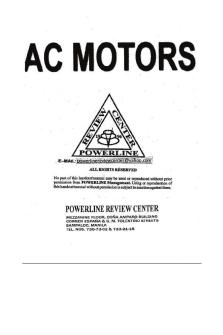
AC Motors101 Electrical Engineering
- 17 Pages

Electrical engineering - Wikipedia
- 18 Pages

UEE UNIT-1 notes of utilization
- 18 Pages

Mechanical Engineering Lecture Notes
- 13 Pages
Popular Institutions
- Tinajero National High School - Annex
- Politeknik Caltex Riau
- Yokohama City University
- SGT University
- University of Al-Qadisiyah
- Divine Word College of Vigan
- Techniek College Rotterdam
- Universidade de Santiago
- Universiti Teknologi MARA Cawangan Johor Kampus Pasir Gudang
- Poltekkes Kemenkes Yogyakarta
- Baguio City National High School
- Colegio san marcos
- preparatoria uno
- Centro de Bachillerato Tecnológico Industrial y de Servicios No. 107
- Dalian Maritime University
- Quang Trung Secondary School
- Colegio Tecnológico en Informática
- Corporación Regional de Educación Superior
- Grupo CEDVA
- Dar Al Uloom University
- Centro de Estudios Preuniversitarios de la Universidad Nacional de Ingeniería
- 上智大学
- Aakash International School, Nuna Majara
- San Felipe Neri Catholic School
- Kang Chiao International School - New Taipei City
- Misamis Occidental National High School
- Institución Educativa Escuela Normal Juan Ladrilleros
- Kolehiyo ng Pantukan
- Batanes State College
- Instituto Continental
- Sekolah Menengah Kejuruan Kesehatan Kaltara (Tarakan)
- Colegio de La Inmaculada Concepcion - Cebu


